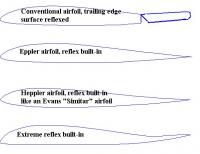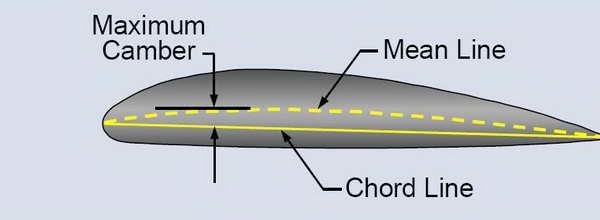

% Step 3: Transform coordinates of circle from zp-plane to z-plane: % Step 2: Compute the coordinates of points on circle in zp-plane: Tea = (nˆ2-1)/3 % This is a Karman-Trefftz extension. N = 2 - te % Number related to trailing edge angle.
05 % 0 < te < 1 (0 => cusped trailing edge)% (4) Select the trailing edge angle parameter:

% (3) Select the shift of y-axis related to camber of the airfoil: % (2) Select the parameter related to thichkness of the airfoil:

% (1) Select the a = angle of attack alpha % Step 1: Select the parameters that define the airfoil of interest. % w = u + i*v => Airfoil (or physical) plane % Complex variables of three complex planes of interest: % Circle in (xp,yp) plane: R = sqrt(xpˆ2 + ypˆ2), R > 1 % Example of conformal mapping of a circle to an airfoil Thus, for an airfoil with zero camber, we predict (3.54) by R/ c = 1/4, where R = 1 is the radius of the unit circle examined in the previous section and c = 4 R is the length of the airfoil chord. However, the lift coefficient is not the same because the length of the airfoil is nearly four times the cylinder's radius. Since the far field is not affected by the transformation, the lift on the airfoil is L = − ρVΓ (i.e., the same as the lift on the cylinder). What is different is the distance between points, and thus the velocity and pressure distributions on the airfoil must be determined from the mapped distribution of the potential. The potential at each point on the cylinder is the same as the corresponding point on the airfoil. Each point on the circle corresponds to a unique point on the airfoil. The figure shows the circle and the airfoil onto which it is mapped.
#Airfoil camber code#
The result of executing this code is illustrated in Fig. MATLAB is very useful here because of its complex arithmetic capabilities. Table 3.8 is a MATLAB script that does this. Instead, we will give an example of applying one of the ideas to illustrate that the circle can be transformed into an airfoil. We are not going to examine complex variable theory here. If we interpret the Cartesian coordinates as the coordinates of the plane of complex numbers z = x+ iy, where x and y are real numbers, i = − 1, x is the real part of z, and y is the imaginary part of z, then doing this allows us to use complex variable theory to solve two-dimensional potential-flow problems. This procedure is known as conformal mapping. We can transform the local geometry of the cylinder into an ellipse, an airfoil, or a flat plate without influencing the geometry of the far-field flow. The solution of the flow around a circular cylinder with circulation in a cross flow can be used to predict the flow around thin airfoils. The failure of the PLK method in this problem is thus perhaps to be expected. But ψ ( n) is not regular at ξ = η = 0, therefore for this approach also no uniformly valid expansion can be obtained.
#Airfoil camber series#
But then the boundary condition would require a power series expansion of ψ ( n) for small ξ and η. The present author has tried to avoid the necessity of expanding x in (4.2) by squaring (4.2) first. If we try to make a formal expansion as Fox did, then the PLK method refuses to yield a uniformly valid solution. 5 in connection with the ordinary differential equations. The same difficulty was discussed in Section II. Since x is not regular at x = 0, such an expansion clearly cannot be uniformly valid. Is there then any warning that we might notice in applying the PLK method to the thin airfoil problem to indicate that the method might fail? It seems that there is such a warning: When we substitute the expansion (4.3) in the equation of the airfoil (4.2) in preparation for satisfying the boundary condition, we have to expand x, among other things, in terms of ξ and x ( n) ( ξ, η), for x near zero. Tsien (1938–1956), 2012 2 Probable Source of Difficulty The method gives best results for slat deflections less than 20 ° and slat-chord-to-airfoil-chord ratios less than 0.20. The DATCOM estimation method, which is presented here, is based on the assumption that the flapped and unflapped airfoils stall when the respective pressure distributions about the noses are the same. Leading edge flaps in use on commercial transport are Krueger flaps (see, for example Torenbeek, 1982) and the approach presented is not applicable to them. Leading edge slat installations on a Boeing 737 and an Airbus A310 are shown in Figures 5.40 and 5.41, respectively. The change in the lift curve produced by the addition of a leading edge slat is shown in Figure 5.39. A schematic illustration of the operation of a typical leading edge slat appears in Figure 5.38.

Modern airliners generally are equipped with slats since they are relatively simple and provide lift augmentation with little drag penalty. A method has been developed for predicting the stall of comparatively thin airfoils with leading edge flaps or slats.


 0 kommentar(er)
0 kommentar(er)
